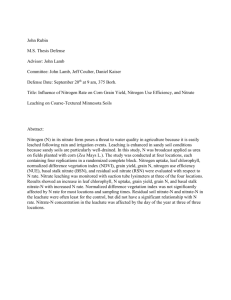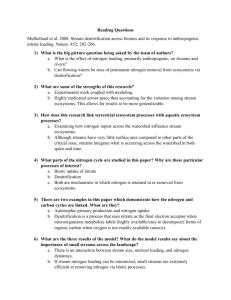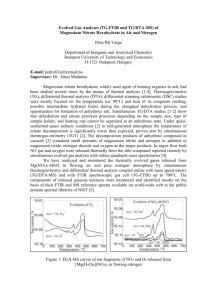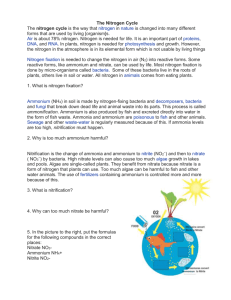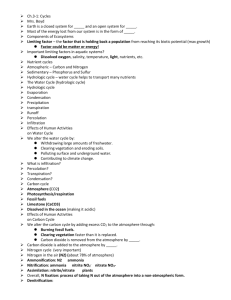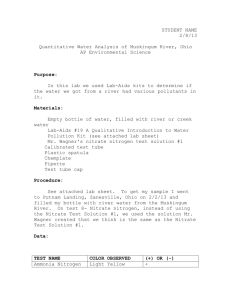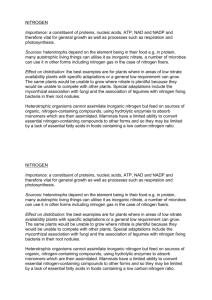Nitrogen Removal 2
advertisement
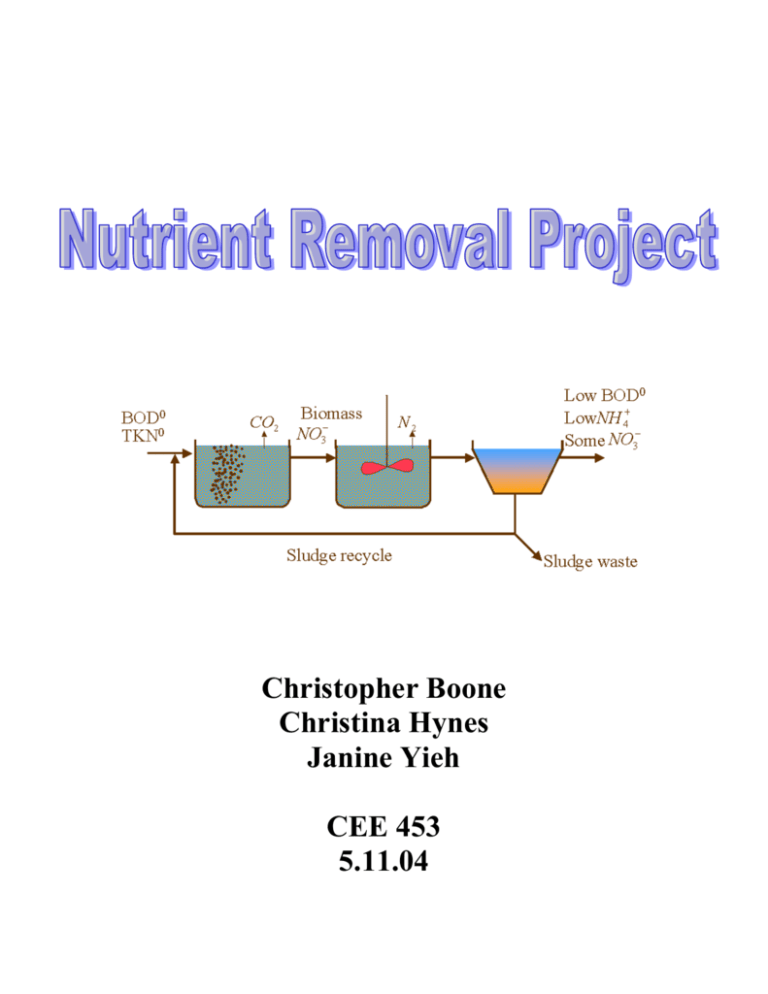
Christopher Boone Christina Hynes Janine Yieh CEE 453 5.11.04 Abstract Eutrophication caused by human activity is an increasing problem for lakes, rivers, and streams around the world. Eutrophication occurs when an excessive amount of nitrogen and phosphorus from runoff and untreated or partially treated wastewater is released into the environment. This causes a spike in algae growth, which can rapidly deplete the dissolved oxygen in a body of water, causing harm to fish and the surrounding ecosystem. For this reason, it is necessary to study the process of nitrogen removal in wastewater treatment plants in order to remove nitrogen efficiently. For our experiment, we studied the processes of nitrification and denitrification in a sequencing batch reactor. We used a nitrate test kit and spectrophotometer in order to measure nitrate concentrations throughout the various stages of our reactor cycles. Initially we found it difficult to achieve nitrification in our plant. After increasing the dissolved oxygen levels during our aeration stage, nitrate began to be formed. In order to achieve higher levels of nitrification, it was necessary to increase the length of the aeration stage. It was also necessary to increase the length of the anaerobic phase in order to allow for significant denitrification. We were unable, however, to achieve complete denitrification in our reactor. Introduction Excessive additions of natural nutrients are currently a major source of water pollution in the United States, with disproportionate amounts of nitrogen and phosphorus often contributing to the eutrophication of lakes. Natural eutrophication is the process by which lakes age and become more productive, but human activities have greatly accelerated this process in many areas around the world. The excess of nutrients causes algae to flourish, depleting the oxygen levels in the water and killing fish or other aquatic animals. There are also certain human health concerns associated with the eutrophication of lakes, such as the spread of Escherichia coli. Algae blooms are aesthetically unpleasing since they can cause foul odors and spoil beaches and shorelines. Humans contribute to the addition of excessive amounts of nitrogen, phosphorus, and carbon in many ways. Some major sources of effluent include runoff from agricultural fields, golf courses, and urban lawns, in addition to untreated or partially treated sewage effluent. In order to prevent the occurrence of lake eutrophication, it is a priority for wastewater treatment facilities to remove these nutrients from the sewage prior to discharge into receiving waters. Nitrogen removal can be accomplished by several methods. Nitrogen removal in activated sludge processes can be done by assimilation into new cell tissue and subsequent sludge wasting, but in most municipal and many industrial wastewaters, excess nitrogen exists that cannot be removed by conventional treatment (Schroeder 266). In cases of excess, nitrogen may be removed by nitrification followed by denitrification where nitrogen is released in the form of nitrogen gas. This significantly decreases the concentration of nitrites and nitrates in the effluent, which can be the limiting reagent for eutrophication in many shallow lakes and estuaries. Nitrification More than 90% of the nitrogen in raw domestic wastewater is in the form of ammonia or compounds from which ammonia is readily formed (Culp 53). With proper environmental conditions during treatment, the ammonia will be converted to nitrate. The nitrogen compounds found in raw sewage may be biologically oxidized provided that the proper environment is maintained in a biological treatment process. When nitrogen-containing organic material is oxidized, ammonia-valence nitrogen is released into solution. This nitrogen is available as a nitrogen and energy-source for the nitrifying bacteria, posing as an oxygen-demand threat to receiving waters (Schroeder 262). Nitrifying bacteria, however, converts these nitrogen compounds to nitrites ( NO2 ) and nitrates ( NO3 ) . There are two groups of nitrifying bacteria: Nitrosomonas, which oxidizes ammonia nitrogen to nitrite, and Nitrobacter, which oxidizes nitrite to nitrate: Nitrosomonas 2 [ NH 4 ] 3 [O2 ] 2 [ NO2 ] Equation 1 Nitrobacter 2 [ NO2 ] [O2 ] 2 [ NO3 ] Equation 2 There are certain conditions that are necessary to carry out nitrification in the activated sludge process. The pH level should be between 6.5 and 8 and the temperature should be around 25˚ Celsius in order to achieve optimal levels of nitrification. For every 10˚ Celsius the temperature increases, the nitrifier growth rate doubles. There must also be a significant amount of dissolved oxygen of at least 2 mg/L in the system. Certain compounds such as mercury, zinc, and ethanol can inhibit the nitrification process, so care must be taken that these compounds are not present in the sludge reactor. Denitrification Denitrification occurs in the anaerobic stages of the treatment process. The organic cells use nitrogen as the electron acceptor when oxygen is not present, so dissolved oxygen levels above 0.3 mg/L will inhibit the denitrification process (Culp 397). During denitrification, nitrate or nitrite is reduced to nitrogen gas, which is then released into the atmosphere. This step decreases the amount of nitrate and nitrite that would normally be found in the effluent of untreated activated sludge. Denitrification [ NO2 ] or [ NO3 ] [ N 2 gas] [ N 2 O] Equation 3 In large-scale systems, the wastewater is moved into a secondary clarifier for the anaerobic stage where the residence time system is extended to at least two or three days long and an organic carbon source is added. The source of available carbon greatly affects the rate at which denitrification occurs. The highest rate will be achieved by an easily assimilated carbon source such as methanol, but this is costly to purchase and store. The addition of raw sewage will act as an effective carbon source, but the denitrification rate will be lowered. In addition, denitrifiers are generally less sensitive to inhibitory compounds than nitrifiers. Objectives The purpose of our experiment is to examine the effectiveness of nitrogen removal in our sequencing batch reactor. We would like to design our plant for optimum removal of nitrogen. In order to do this, we originally intended to compare the total nitrogen removal for two different plant configurations. The first configuration was to model a single aeration stage followed by a single anaerobic stage, and the second was a modified version of the Barnard Process. Unfortunately, we were never able to test the second plant configuration due to having difficulties achieving any nitrification during the first configuration, and it was doubtful that the Barnard Process would have produced any different results. Instead, we decided to refocus our efforts on achieving better nitrification and denitrification within our plant. Materials & Methods Plant Configuration The traditional Barnard Process begins with an anaerobic stage to allow for denitrification to occur. In this stage, synthetic waste serves as the primary electron donor for conversion of nitrate to nitrogen gas. This stage is then followed by a long aeration phase, and then another anaerobic phase. In this second anaerobic phase, biomass (i.e. the bacterial cells) serves as the primary electron donor for further denitrification. Another short aeration phase then follows. Figure 1. Barnard Process. For our modified version of the Barnard Process, we intended to begin the process with an extra aeration phase in order to allow for initial nitrate formation. As shown above in Figure 1, when the Barnard Process is carried out in a continuous flow reactor, some of the effluent from the first aeration step is recycled back to the first anaerobic reactor. Since nitrification occurs in the aeration process, the result is the recycling of some nitrate back to the first step, allowing for a better breakdown of nitrogen. Figure 2. Barnard Process in a Sequencing Batch Reactor As shown in Figure 2, when the Barnard Process is modeled in a sequencing batch reactor, none of the waste in the initial anaerobic stage will have undergone an aeration phase (i.e. nitrification), since there is no sludge recycle from the previous process. Hence, there would likely be a low concentration of nitrate in this first anaerobic stage, and therefore little denitrification, since our incoming organic waste contains nitrogen mainly in the form of ammonium. For this reason, we decided to add an additional aeration stage in the beginning of the process. This stage would hopefully allow for some nitrification to occur, but would not be long enough to break down all of the incoming waste, leaving some of the waste to serve as the electron donor for denitrification in the following anoxic stage. Our second configuration will utilize biomass storage and decay. This process will begin with an aeration phase in which nitrification can occur and the BOD can be depleted. This phase will then be followed by an anaerobic stage, which will allow for denitrification to occur. The primary electron donor will be our biomass. Figure 3 shows an outline of this process for a traditional treatment plant. Since we will be employing a sequencing batch reactor, most of the waste will exit with the effluent, while the bulk of the biomass (cells) will remain at the end of the cycle. Figure 3. Biomass Storage & Decay. Control Logic We used the Process Controller software (v2.0) to control our plant. Table 1 shows the list of states for our reactor, along with the exit condition for each. Table 1. States and exit conditions for our sequencing batch reactor. State Add organic feed Fill with water1 Aerate Stir Settle Drain Exit Condition Elapsed time > pump time for organic feed Reservoir level > max reservoir level Elapsed time > max aeration time Elapsed time > max stir time Elapsed time > max settling time Reservoir level < min reservoir level The overall residence time for our reactor was 6 hours. Since we were unable to employ the Barnard Process, the control logic shown in Table 1 is the same logic used throughout our entire experiment. We did, however, vary the length of certain set points throughout our experiment. The initial values for our set points are shown below in Table 2. Table 2. Values for control logic set points. Set Point Max aeration time (seconds) Max stir time (seconds) Max settling time (seconds) Max reservoir level (mL) Min reservoir level (mL) Initial Value 8700 8700 3600 4000 1000 Final Value 13,800 3600 3600 4000 1000 As Table 2 shows, for the latter stage of our experiment, we increased the duration of the aeration phase and decreased the duration of the anaerobic (stirring) phase. This was done in an effort to increase nitrate formation in the reactor, while keeping the hydraulic residence time the same. For both setups, the hydraulic residence time remained 6 hours. We used a peristaltic pump to add both the organic waste and the water to our plant. A pressure sensor was used in order to measure the level of water in the reactor in order to determine when to stop adding water and to stop draining. We also used a dissolved oxygen probe to measure the DO concentration; data for DO concentration was continuously logged to a computer file while the plant was in operation. The rubber end of the stirring rod was used to clean the sides of the tank. It was used in a spatula-like manner to feverishly scrape the sludge. Rubber gloves were worn throughout this procedure - in a manner similar to that of wearing oven mitts while baking. A paper towel was sometimes draped over the top of the reactor in order to keep sludge from splashing onto the tabletop. Nitrate Testing For our experiment, we were unable to obtain a Nitrate Probe that would accurately determine and record the nitrate concentrations within our reactor. Instead, we purchased a Nitrate Test Kit. This kit uses cadmium and other reagents to determine nitrate concentrations. When these reagents are added to solutions containing high concentrations of nitrate, the solution turns a deep shade of red. The intensity of the red color corresponds to the nitrate concentration, which can be determined using either the color viewing apparatus supplied with the test kit or a spectrophotometer. We decided to use a UV Spectrophotometer in order to determine the nitrate concentration for our treated samples. Standards were prepared with concentrations ranging from 0 to 7 mg/L nitrate nitrogen. We then tested these standards using the nitrate test kit, and analyzed them using the spectrophotometer. All of the samples from our plant were compared against these standards using the nitrate test kit and spectrophotometer. The sample concentrations were determined using the absorbance at 542 nm. All of the samples were taken from the top of the reactor, allowed to settle for at least 15 minutes, and then filtered before performing the tests. Since our highest standard concentration was 7 mg/L, all of our samples were diluted until the spectrophotometer measured concentrations of 10 mg/L or less, in order to minimize error due to extrapolating. We also attempted to analyze our samples without the use of the nitrate test kit, according to the procedure provided on the CEE 453 website (Weber-Shirk). For this procedure, we created 50 mL standards ranging from 0 to 10 mg/L nitrate nitrogen, and added 1 mL of 1 N HCl to each sample. These samples were then analyzed using the spectrophotometer, and the greatest correlation was observed at a wavelength of 220 nm (r value = 0.9999). We then analyzed our filtered samples in the spectrophotometer (adding only HCl) and compared the absorbance values against our standards in order to determine a value for the nitrate nitrogen concentration. Results & Discussion Nitrogen Removal Our plant was initially set to aerate for 8700 seconds and to stir without aerating for another 8700 seconds. After operating in this manner for over two weeks, we took samples in order to measure the nitrate concentration. The nitrate test was performed on samples taken throughout the entire process, from the addition of the synthetic waste until the effluent was drained. The resulting nitrate nitrogen concentrations (using the test kit) were minimal. Not a single sample turned red, and the spectrophotometer returned negligible (or even negative) nitrate nitrogen concentrations at a wavelength of 542 nm. These unexpected results led us to rethink our objectives. Before we could perform any sort of analysis on the effectiveness of nitrogen removal, we needed to first make our plant conducive to the nitrification-denitrification process. We determined the pH of the plant to be around 8.6, which is within the optimal range for both nitrification and denitrification. The temperature of our plant was about 21°C, which is slightly lower than the optimal 25°C, but not low enough to completely inhibit nitrification. We then turned our attention to the dissolved oxygen concentration. Since each new membrane on the DO probe would only seem to give accurate readings for the first 2 or 3 days, we realized the DO readings were unreliable at best. We replaced the membrane again and found that our DO concentrations were staying low well into the aeration phase. The DO concentrations had initially started out high during the aeration phase for the first few weeks that our plant was running. But as the plant ran longer, the air flow rate seemed to be dropping, and the DO measurements confirmed that our DO level was rarely exceeding 4 mg/L. This was probably due in part to the aeration stone becoming clogged with sludge. Nitrate Concentration (mg/L NO 3--N) We suspected the low DO level to be what was inhibiting nitrification, so we increased the air flow rate and closely monitored the DO levels to make sure they stayed above 5 mg/L. After the reactor ran through a few cycles aerating at high DO levels, we again tested the nitrate levels through the various stages of the cycle. The resulting concentrations are shown in Figure 4. 3 2.5 2 1.5 1 0.5 0 Beg aeration During aeration (1hr) End aeration Effluent Figure 4. Nitrate nitrogen concentrations for initial reactor configuration. Aeration time was 8700 seconds; anaerobic stirring duration was 8700 seconds. The increase in DO levels seemed to stimulate the start of the nitrification process. Now that we were getting nitrate formation in the reactor, we began to think about how to make it more effective. Since we were adding at least 40.9 mg/L nitrogen to the reactor (in our synthetic waste), NO3--N levels of 2.75 mg/L at the end of aeration (Figure 4) mean that complete nitrification was not taking place. Since the increase in DO levels during the aeration phase seemed to have helped, we decided to run the aeration phase for a longer period of time to see what nitrate levels could be achieved. We kept the total hydraulic residence time of our reactor the same, and simply increased the total aeration time by decreasing the amount of time spent in the anaerobic stage. The resulting nitrate nitrogen concentrations are shown in Figure 5. Nitrate Concentration (mg/L NO 3--N) 45 40 35 30 25 20 15 10 5 0 Beg aeration During aeration (2.5 hrs) End aeration Effluent Figure 5. Nitrate nitrogen concentrations for second reactor configuration. Total aeration time was 13,800 seconds; total anaerobic stirring duration was 3600 seconds. It is clear from Figure 5 that the increase in total aeration time significantly benefited the nitrification process. By the end of 13,800 seconds of aerating, we had achieved nitrate nitrogen levels of 41.8 mg/L. However, since we only allowed the reactor to stir without oxygen for 3600 seconds, there was not enough time for denitrification to occur. In fact, the measured nitrate nitrogen concentration in our effluent (after denitrification) was even higher than was measured at the end of aeration. This is likely due to the error in determining the concentration; however, it is not encouraging since nitrate levels should be depleted during the denitrification process. We decided that with the current setup of our plant, it would be very difficult to achieve total nitrification and denitrification and still maintain the residence time of 6 hours. We decided to set the plant to aerate for a very long time (18 hours), and then stir anaerobically for another 11 hours. We measured the concentrations throughout the process and the results are shown below in Figure 6. Nitrate Concentration (mg/L NO 3--N) 140 120 100 80 60 40 20 0 Beg aeration During aeration (4 hrs) End aeration During stir (4 hrs) End stir Figure 6. Nitrate nitrogen concentrations for final experiment. Total aeration time was about 18 hours; total anaerobic stirring duration was about 11 hours. From our results, we have concluded that both the processes of nitrification and denitrification seem to be occurring relatively slowly, and for our sequencing batch reactor it is difficult to achieve complete nitrogen removal with a residence time of 6 hours. It seems to be very important to keep the dissolved oxygen concentration very high (above 5 mg/L) during the aeration phase in order to achieve nitrification. It is possible that the nitrification process could be accelerated by heating the reactor contents to the optimum temperature for nitrification (25°C). The denitrification process might be occurring slowly because we are using the cell biomass as the electron donor. This might explain why the process appears to have stalled after 4-hours; that is, perhaps the biomass took all the electrons it could, and caused the denitrification process to stop. Denitrification could likely be speeded up by adding some sort of additional organic electron donor (such as methanol), or perhaps by configuring the plant to use the incoming waste as an electron donor (as we had planned to, using our modified Barnard Process). Testing Method One of the objectives of this experiment was to determine the feasibility of the alternate process of determining nitrate concentration (as outlined at the CEE 453 website). This method involves analyzing the absorbance at 220 nm using a spectrophotometer, without the use of a nitrate test kit. We were unable to use this method to accurately measure nitrate concentrations. It works well for solutions containing only a nitrate compound, but we were unable to find a simple method by which we could accurately determine the nitrate concentrations in our (filtered) NRP samples. The other compounds in the samples seem to inhibit accurately measuring the nitrate concentrations. The procedure outlined in the Ultraviolet Spectrophotometric Screening Method Nitrate concentration (mg/L NO 3--N) instructs the experimenter to subtract twice the absorbance at 275 nm from the absorbance at 220 nm. This method proved quite inadequate for our samples. The absorbance at 275 nm was at times very small and yielded a meaningless correction. At other times, the absorbance at 220 nm was much less than it should have been, so any additional correction would have made the measured concentration even more inaccurate. 140 Without test kit 120 With test kit 100 80 60 40 20 0 Beg During End During stir aeration aeration (4 aeration (4 hrs) hrs) End stir Figure 7. Nitrate nitrogen concentrations for the same test from Figure 6. Results given for measured concentrations using the test kit (same as Figure 6) and without using the test kit. As you can see from Figure 7, the measured nitrate concentrations are significantly higher when using the test kit. The concentrations without the test kit follow the same increasing-decreasing pattern (which corresponds to the nitrification-denitrification process), which is encouraging. This means that the observed absorbance values likely correspond somehow to the nitrate concentration. Nonetheless, we have been unable to determine an appropriate correction factor that can be used to turn these absorbance values into actual nitrate nitrogen concentrations. Conclusion Our experiments have led us to the conclusion that it is more difficult to achieve nitrogen removal within the reactor than it is to achieve removal of BOD. A longer residence time seems to be necessary to allow for complete nitrification and denitrification. Aerating the reactor at high DO levels, will likely remove all BOD long before the process of nitrification has continued to completion. Denitrification also seems to be a slow process. Further experimentation is necessary in order to compare the efficiency of denitrification when using various electron donors. It is likely that a process that utilizes the synthetic waste as electron donor (e.g. the Barnard Process) would allow for more efficient denitrification. Suggestions Our recommendation to future groups studying nitrate removal is to not limit yourself to a 6-hour residence time. It seems to be quite difficult to coax your reactor into the nitrificationdenitrification process if you have a short residence time. It would be more feasible to perform an experiment (say, comparing the modified Barnard Process described above to the biomass storage and decay process that we employed) if you shoot for a residence time of 12 hours or more. This will probably allow you to select for bacteria effective at nitrogen removal early on in the project, and will give you more time to do experimentation. Also, be aware that it takes a good deal of time to test samples using the nitrate test kit. It might be worthwhile to jump on the nitrate probe that has already been purchased, so that you can continuously log data and do not need to repeatedly take samples. Overall we enjoyed the nutrient removal project. Christina especially enjoyed the deep conversations she had with the biomass. Chris never really got over the fact that we were dealing with real "biomass" and he cried like a baby every time his skin made contact with the sludge. Janine always kept a current log of the refill schedule and mastered the delicate art of colored tape folding. References Culp, Russell L., and Gordon L. Culp. Advanced Wastewater Treatment. New York: Litton Educational Publishing, Inc., 1971. 53, 394-398. Schroeder, Edward D. Water and Wastewater Treatment. New York: McGraw-Hill, Inc., 1977. 262-77. Tchobanoglous, George, and Edward D. Schroeder. Water Quality. N.p.: Addison Wesley Publishing Company, Inc., 1985. Weber-Shirk, Monroe. Ultraviolet Spectrophotometric Screening Method. Available at http://ceeserver.cee.cornell.edu/mw24/cee453/NRP/UV%20nitrate%20method.doc. See bibliography provided in document for sources.


